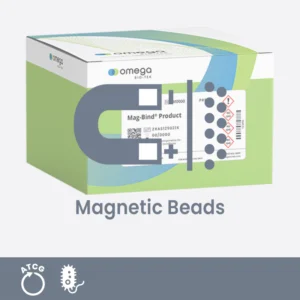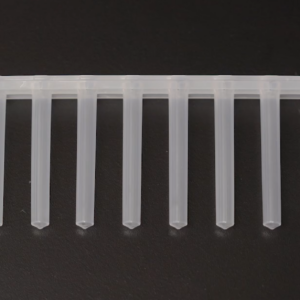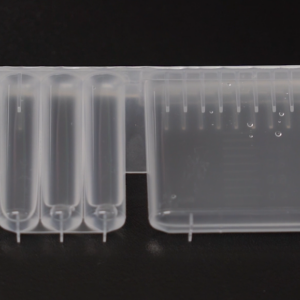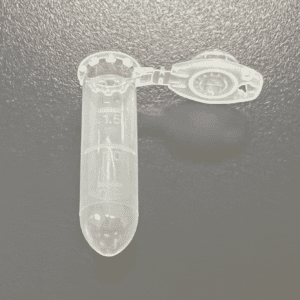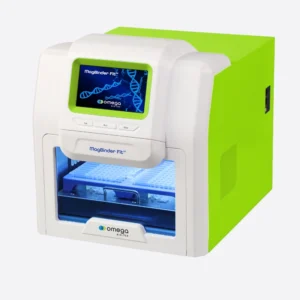Steven Cupello¹, Chris Stuart¹, Kiranmai Durvasula¹, Julie Baggs¹, and Travis Butts¹
¹Omega Bio-tek, Inc., Norcross, GA 30071
MagBinder® Fit24 Nucleic Acid Purification System
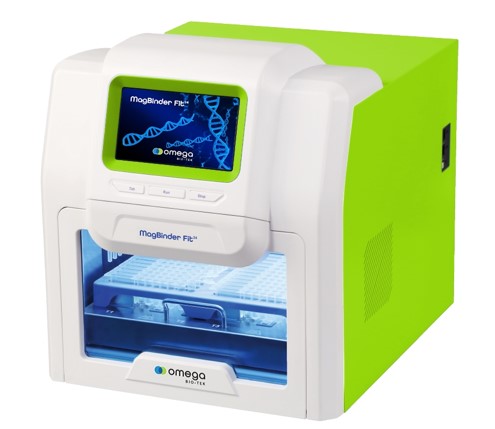
The MagBinder® Fit24 is a new benchtop nucleic acid purification system designed to meet the needs of low-to-moderate throughput users by providing semi-automated purification of 1 to 24 small or large volume sample inputs. This automation platform can support various DNA and RNA workflows, sample versatility, and flexible input volumes to achieve consistent, high-quality results.
Table 1. Plasmid Kits and Specifications for automating on MagBinder® Fit24 Platform
| Kit | Input Culture Volume | Reagent Cartridge to Use | Lysate Clearance Methodology | Elution Volume | *Processing Time on MagBinder® Fit24 |
|---|---|---|---|---|---|
| Mag-Bind® Endo-free Plasmid Mini Kit | Up to 1.5 mL LB or TB | MB Fit24™ Reagent Cartridge, 5 mL | Centrifucation or Mag-Bind® Particles LC | 50-100 µL | ~65 min |
| Mag-Bind® Endo-free Plasmid Midi Kit | Up to 5 mL LB | MB Fit24™ Reagent Cartridge, 5 mL | Centrifugation or Mag-Bind® Particles LC or Lysate Clearance Syringe | 100 µL | ~70 min |
| Mag-Bind® Endo-free Plasmid Midi Kit | Up to 50 mL LB or 10 mL TB | MB Fit24™ Reagent Cartridge, 10 mL | 500-1000 µL (250 µL for < 25 mL culture volume input) | ~70 min |
Plasmid Purification Made Easy
The MagBinder® Fit24, in conjunction with magnetic bead-based purification kits, like the Mag-Bind® Endo-free Plasmid Mini Kit (M1261) and Mag-Bind® Endo-free Plasmid Midi Kit (M1272), offers a scalable, one-stop solution for plasmid purification encompassing mini to midi preps. Up to 50 mL bacterial cultures grown in Luria-Bertani (LB) medium or up to 10 mL bacterial cultures grown in Terrific Broth (TB) can be processed using this workflow. The reagents from the purification kits are user-filled into 5 mL (PB07-5-200) or 10 mL (PB05-10-200) reagent cartridges. The cartridge layout for Mag-Bind® Endo-free Plasmid Mini and Midi Kits is shown in Figure 2. The Mag-Bind® Endo-free Plasmid Mini and Midi Kits follow a modified alkaline lysis method, forming a bacterial lysate. The lysate is then cleared using either lysate clearance beads (Mag-Bind® Particles LC) or centrifugation. Lysate Clearance Syringe can also be used in the case of a midiprep. The upfront alkaline lysis and lysate clearance are carried out offline. The lysate is transferred to Well 1 of the reagent cartridge and subsequent bind-wash-elute steps are performed on the Magbinder® Fit24. Eluted Plasmid DNA is high-quality, endotoxin-free wih endotoxin levels <0.1 EU/µg. The information about the plasmid purification kits and their specifications are shown in Table 1.
5 mL Reagent Cartridge Layout for Minipreps
(Up to 1.5 mL bacterial culture)

10 mL Reagent Cartridge Layout for Midipreps
(Up to 50 mL bacterial culture)

| Position | Contents | Mag-Bind® Endo-free Plasmid Mini Kit (M1261) - up to 1.5 mL culture input | Mag-Bind® Endo-free Plasmid Midi Kit (M1272) - up to 5 mL culture input | Mag-Bind® Endo-free Plasmid Midi Kit (M1272) - up to 50 mL culture input |
|---|---|---|---|---|
| 1 | IRD Buffer + Mag-Bind® Particles RQ | 500 µL IRD Buffer + 50 µL Mag-Bind® Particles RQ | 2.5 mL IRD Buffer + 50 µL Mag-Bind® Particles RQ | 5 mL IRD Buffer + 200 µL Mag-Bind® Particles RQ |
| 2 | IRD Buffer | 500 µL | 1 mL | 1.25 mL |
| 3 | VHB Buffer | 700 µL | 1 mL | 1.25 mL |
| 4 | VHB Buffer | 700 µL | 1 mL | 1.25 mL |
| 5 | 70% Ethanol | 700 µL | 1 mL | 1.25 mL |
| 6 | Empty | Empty | Empty | Empty |
| 7 | Empty | Empty | Empty | Empty |
| Elution Tube | Endo-free Water | 50 - 100 µL | 100 µL | 500 - 1000 µL |
Figure 2. MagBinder® Fit24 reagent cartridge positions, contents, volume used in Mag-Bind® Endo-free Plasmid Mini and Midi Kits
Plasmid Purification: Minipreps
Plasmid Purification from 1.5 mL LB, TB, and 2xYT
E. coli strain DH5α harboring high copy number plasmid pGL4.51 was grown overnight in 2xYT or TB media. DH5α harboring pGEM was grown overnight in LB medium concurrently. Plasmid DNA was purified using Mag-Bind® Endo-free Plasmid Mini Kit on the MagBinder® Fit24 and quantified by absorbance using Thermo Scientific’s NanoDrop™ 2000c system. Run time was ~65 minutes. Yield and purity of plasmid DNA is shown in Figure 3. The results corroborate the versatility of the extraction workflow that is capable of handling diverse sample input conditions ranging from plasmid types, plasmid sizes, culture medium, and input culture volumes.
Versatility Across Various Culture Media and Plasmid Types

Table 2. ~1.8X higher plasmid yield vs Company P
| Manufactuer | Yield (µg) | A260/A280 | A260/A230 | Endotoxin levels (EU/µg) |
|---|---|---|---|---|
| Omega Bio-tek | 7.0 | 1.84 | 7.98 | 0.02 (endotoxin-free) |
| Company P | 3.9 | 1.84 | 1.98 | 0.14 |
Comparison Data vs Company P Using 1.5 mL Input Culture Volume
pGEM plasmid was purified from 1.5 mL DH5α cultures (n=3) using Mag-Bind® Endo-free Plasmid Mini Kit automated on MagBinder® Fit24 and a comparable magnetic bead-based kit from Company P, following manufacturer’s recommended protocol. Purified Plasmid DNA was quantified using Thermo Scientific’s NanoDrop™ 2000c system. Plasmid preparation was not only endotoxin-free (<0.1 EU/µg) for Omega Bio-tek’s kit, but the yield was also significantly higher (~1.8X) compared to Company P’s kit (Table 2).
Higher Transfection Efficiency vs Company P
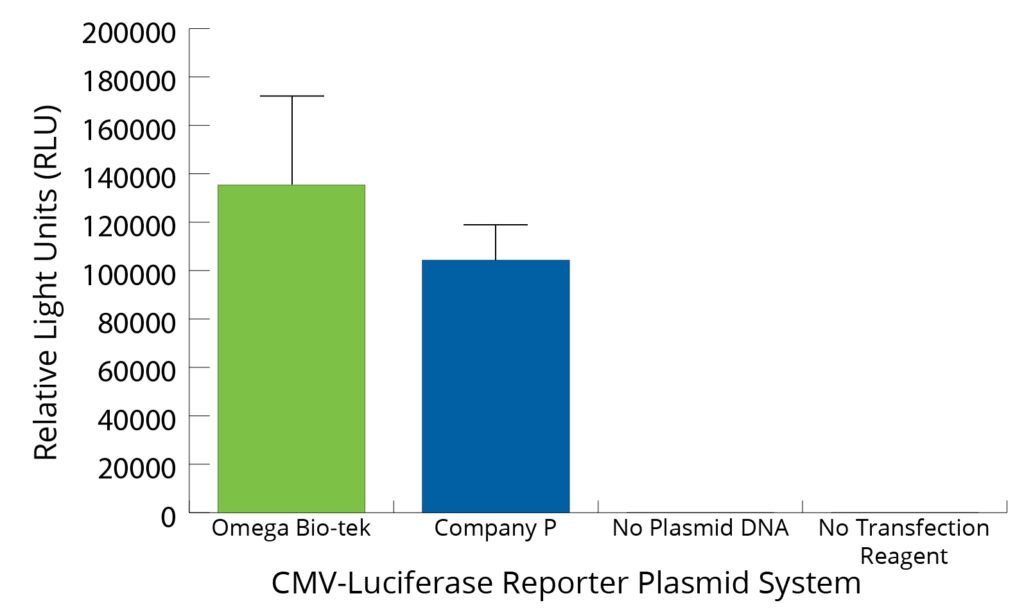
Downstream Application of Transfection
Plasmid pGL4.51 which encodes the luciferase gene was prepared using both Omega Bio-tek’s Mag-Bind® Endo-free Plasmid Mini Kit automated on MagBinder® Fit24 and Company P’s Kit, following manufacturer’s recommended protocol. 200 ng of purified plasmid using both methodologies was transfected into 10,000 cells using 2 µL Lipofectamine Transfection Reagent. Plasmid purified using Omega Bio-tek’s Kit resulted in higher bioluminescent signal, indicating higher transfection efficiency, compared to plasmid purified using Company P’s kit (Figure 4). The higher transfection efficiency achieved using Omega Bio-tek’s workflow is likely because the plasmid purification was endotoxin-free using Omega Bio-tek’s Kit.
Plasmid Purification : Midipreps
Table 3. Significantly higher plasmid yields compared to Company T using 5 mL input culture volume.
| Plasmid | Manufacturer | Yield (µg) | A260/A280 | A260/A230 | Endotoxin levels (EU/µg) |
|---|---|---|---|---|---|
| pGEM (~3.3 kb) | Company T | 9.0 | 1.9 | 2.4 | 0.651 |
| Omega Bio-tek | 31.7 | 1.8 | 2.1 | <0.01 (endo-free) | |
| pGL4.51 (high-copy) (~6.4 kb) | Company T | 10.2 | 1.9 | 2.3 | Not Available |
| Omega Bio-tek | 87.5 | 1.8 | 2.2 | Not Available |
Comparison data vs Company T using 5 mL input culture volume
pGEM and pGL4.51 plasmid were purified from 5 mL DH5α cultures (n=3) using Mag-Bind® Endo-free Plasmid Midi Kit on the MagBinder® Fit24 and Company T’s Kit, following manufacturer’s recommended centrifugation protocol. Purified Plasmid DNA was quantified using Thermo Scientific’s NanoDrop™ 2000c system. Plasmid preparation was not only endotoxin-free (< 0.1 EU/µg) for Omega Bio-tek’s kit, but the yield was also significantly higher compared to Company T’s kit (Table 3).
Higher Transfection Efficiency vs Company T
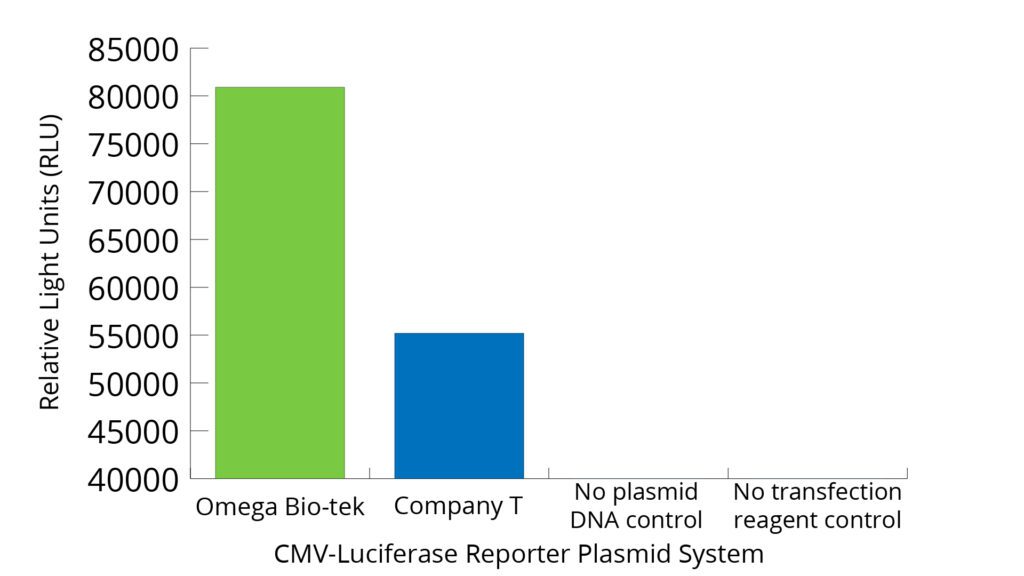
Downstream Application of Transfection
200 ng of plasmid pGL4.51, prepared as described above, was transfected into 10,000 cells using 2 µL Lipofectamine Transfection Reagent. Plasmid purified using Omega Bio-tek’s Kit resulted in higher bioluminescent signal, indicating higher transfection efficiency compared to plasmid purified using Company T’s kit (Figure 5).
Excellent Plasmid Yields and Purity Extracted on MagBinder® Fit24 Platform

Plasmid Purification from 50 mL LB and 10 mL TB
E. coli strain DH5α harboring pGEM was grown overnight in 25 mL LB, 50 mL LB, or 10 mL TB media, following three different lysate clearance methodologies (centrifugation, Mag-Bind® Particles LC, and lysate clearance syringe). Plasmid DNA was purified using Mag-Bind® Endo-free Plasmid Midi Kit on MagBinder® Fit24 and quantified by absorbance using Thermo Scientific’s NanoDrop™ 2000c system. Run time was ~70 minutes. Yield and purity of plasmid DNA is shown below in Figure 6. Yields were comparable irrespective of the lysate clearance methodology used. Plasmid yields roughly doubled from culture volumes 25 mL to 50 mL and had excellent purity ratios with A260/A280 values ~1.8 and A260/A230 values ~2.2. The purified plasmids, irrespective of the culture volume or culture medium, were endotoxin-free with endotoxin levels < 0.1 EU/µg.
Conclusions
MagBinder® Fit24 Nucleic Acid Purification System, in conjunction with Omega Bio-tek’s magnetic bead-based plasmid kits, offers an attractive, all-encompassing solution covering the plasmid purification spectrum from mini to midi preps. Purified plasmid is endotoxin-free that can be used in myriad applications, ranging from sensitive cell transfections to routine screening.
SL-0152
Featured Products
-
Bacterial Plasmid
Mag-Bind® Endo-free Plasmid Mini Kit
$0.00 – $630.00Price range: $0.00 through $630.00 Select options This product has multiple variants. The options may be chosen on the product page -
Bacterial Plasmid
Mag-Bind® Endo-free Plasmid Midi Kit
$0.00 – $984.37Price range: $0.00 through $984.37 Select options This product has multiple variants. The options may be chosen on the product page

